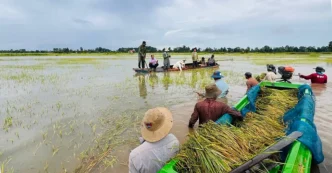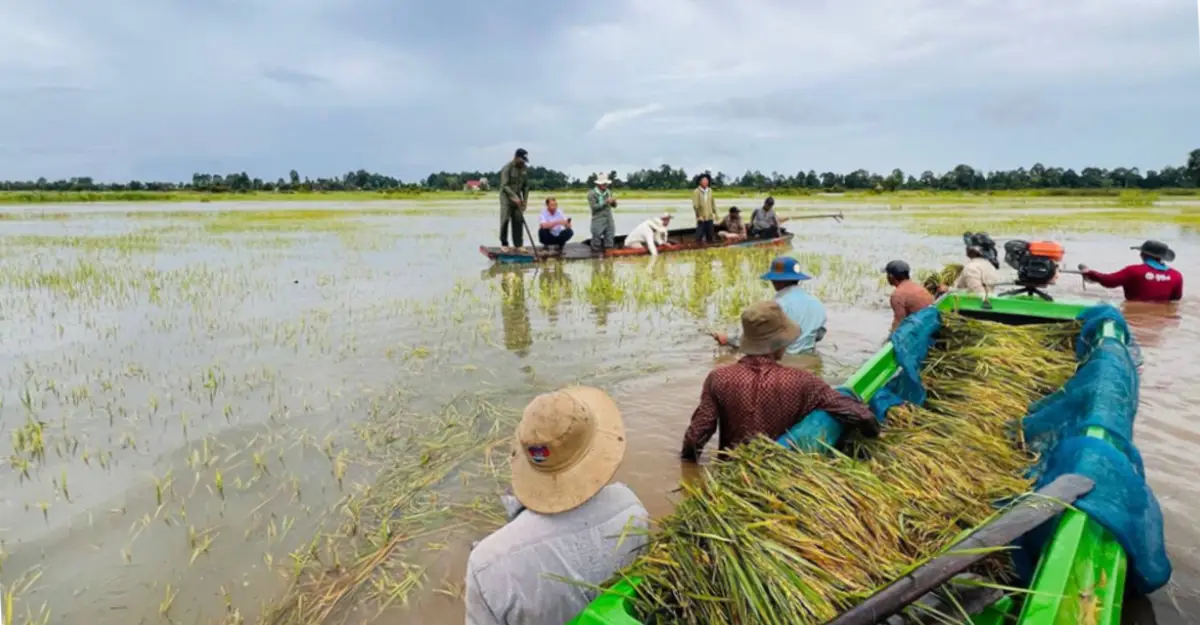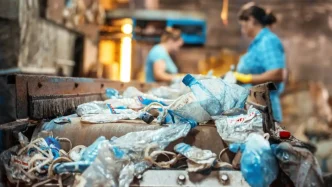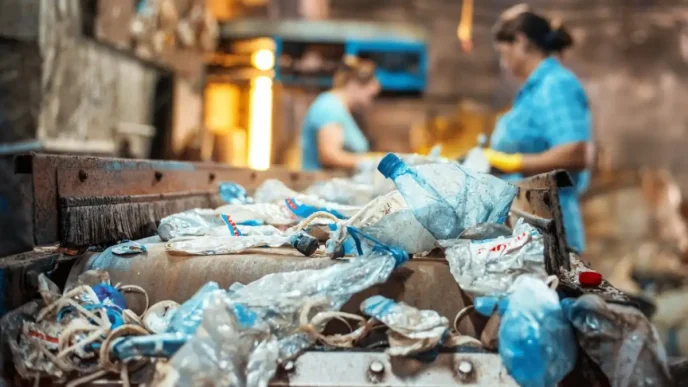Unexpected heavy rainfall has inundated five provinces across Cambodia, disrupting agricultural cycles and threatening out-of-season rice crops vital to local livelihoods. The flooding, reported in Battambang, Pursat, Banteay Meanchey, Pailin, and Kampong Speu, has affected thousands of hectares of farmland, raising concerns about food security and economic stability in a country where agriculture remains a cornerstone of the economy. As authorities scramble to provide relief, questions loom over the increasing frequency of such unseasonal weather events and their ties to broader climate challenges.
Scale of the Deluge
The unseasonal rains, which began in early May 2025, have caught farmers and officials off guard. Typically, Cambodia’s wet season peaks between June and October, with out-of-season rice cultivation designed to maximize yields during drier months. However, the recent downpours have submerged vast swathes of farmland, with preliminary estimates from the Ministry of Agriculture, Forestry and Fisheries suggesting over 10,000 hectares of rice crops have been damaged or destroyed. Battambang, often dubbed the “rice bowl” of Cambodia, has borne the brunt, with entire villages cut off by rising waters.
Local farmers, many of whom rely on these harvests for income and subsistence, face immediate hardship. “We planted expecting a dry spell, but now everything is underwater” said Sovan Keo, a farmer from Pursat province, in an interview with local media. The loss of crops not only threatens household incomes but also risks driving up rice prices in local markets, a critical concern for a nation where rice is a dietary staple.
Government and Community Response
The Cambodian government has mobilized emergency response teams, with the National Committee for Disaster Management (NCDM) coordinating relief efforts. Temporary shelters have been established for displaced families, and food aid is being distributed in the hardest-hit areas. Prime Minister Hun Manet has publicly assured citizens that additional resources, including financial assistance for affected farmers, are being allocated. “We stand with our people during this difficult time” he said during a televised address on May 22, 2025, as reported by local outlets.
Non-governmental organizations and community groups are also stepping in. The Cambodian Red Cross has deployed volunteers to assist with evacuations and distribute hygiene kits, while local monks have opened pagodas as refuge centers. Despite these efforts, logistical challenges persist, particularly in remote areas of Banteay Meanchey and Pailin, where flooded roads have hampered aid delivery.
Financial support remains a pressing need. The government has announced compensation packages, though details on amounts and eligibility are still emerging. Some farmers have expressed skepticism about the speed of disbursements, recalling delays during past disasters. For now, many are turning to loans or personal savings to weather the crisis, a strategy that could deepen cycles of debt in rural communities.
Economic Ripple Effects
Cambodia’s economy, heavily reliant on agriculture, faces significant risks from the flooding. Rice production accounts for roughly 16% of the country’s GDP and employs a large portion of the rural workforce. Out-of-season cultivation, supported by irrigation advancements, has been a key strategy to boost output and stabilize incomes. The current losses, if not mitigated, could disrupt export targets—Cambodia shipped over 600,000 tons of milled rice in 2024, much of it to European and Asian markets—and strain domestic supply chains.
The financial toll is already evident. Initial assessments suggest damages could reach millions of dollars, with repair costs for infrastructure like roads and irrigation systems adding to the burden. In Kampong Speu, where small-scale farmers often lack insurance, the cost of replanting alone is prohibitive. One estimate pegs the expense at 1.2 million Cambodian Riel (US$290) per hectare, a sum beyond the reach of many without external support.
Beyond agriculture, the flooding has disrupted local businesses and markets. In Pursat, traders report a sharp drop in foot traffic as flooded roads deter customers. The broader economic impact may depend on how quickly waters recede and whether further rains exacerbate the situation, a possibility meteorologists have not ruled out given shifting weather patterns in the region.
Climate Change Connection
While immediate relief takes precedence, the flooding has reignited discussions about climate change and its impact on Cambodia’s agricultural heartlands. Experts note that unseasonal rainfall and extreme weather events are becoming more frequent across Southeast Asia, driven by global warming and phenomena like La Niña, which can intensify monsoon activity. A 2024 report by the Intergovernmental Panel on Climate Change (IPCC) warned that low-lying nations like Cambodia are particularly vulnerable to such disruptions, with rising temperatures and erratic precipitation threatening food systems.
Local environmentalists are calling for stronger adaptation measures. “We need better forecasting tools and flood-resistant crops if we’re to survive these changes” said Chenda Sok, a climate advocate based in Siem Reap, in a recent statement to regional media. Infrastructure improvements, such as enhanced drainage systems and embankments, have been proposed, though funding and implementation remain hurdles. Cambodia’s reliance on international aid for climate resilience projects adds another layer of complexity, as geopolitical priorities often influence donor commitments.
For farmers, the connection to climate change is less academic and more visceral. Many report noticing shorter dry seasons and unpredictable rains over the past decade, trends that align with scientific observations. If these patterns persist, as studies suggest they may, the viability of out-of-season farming—a lifeline for rural economies—could be at risk, forcing a reevaluation of traditional agricultural practices.
Regional Context and Comparisons
Cambodia is not alone in grappling with unseasonal flooding. Neighboring Thailand and Vietnam have also faced similar challenges in recent years, with heavy rains disrupting rice production in the Mekong Delta and northern Thai provinces. In 2023, Vietnam reported losses of over 50,000 hectares of crops due to unexpected storms, a situation that prompted emergency subsidies and international aid appeals. These shared struggles underscore the regional nature of climate-driven weather anomalies, prompting calls for cross-border cooperation on disaster preparedness and resource sharing.
Unlike its neighbors, however, Cambodia’s capacity to respond is constrained by lower levels of infrastructure investment and institutional readiness. While Thailand has developed extensive flood barriers in key agricultural zones, Cambodia’s systems remain patchwork, often overwhelmed by sudden deluges. Learning from regional models, while adapting them to local realities, could offer a path forward, though political will and funding remain critical barriers.
Human Stories Amid the Crisis
Behind the statistics lie personal tales of resilience and loss. In Banteay Meanchey, 45-year-old farmer Rathana Lim described wading through chest-deep water to salvage what remained of her rice fields. “This is all we have, and now it’s gone” she said, her voice heavy with resignation, as quoted by a local aid worker. Her family, like many others, faces an uncertain future, with children’s education and daily meals now at risk.
Yet, amidst the hardship, community solidarity shines through. In Pursat, neighbors have pooled resources to share food and shelter, while younger villagers assist the elderly in navigating flooded paths. These acts of mutual support, though small in scale, highlight the strength of rural Cambodian communities in the face of adversity, a trait that has sustained them through past crises, from civil conflict to natural disasters.
Looking Ahead
As floodwaters linger in Cambodia’s provinces, the road to recovery appears daunting. Immediate needs—food, shelter, and financial aid—must be balanced with longer-term strategies to safeguard against future disasters. Whether through climate-resilient farming techniques or enhanced infrastructure, the path forward demands innovation and investment, both of which remain in short supply. For now, the nation watches the skies, hoping for a reprieve from the rains, while grappling with the sobering reality that such events may become the new normal.
















